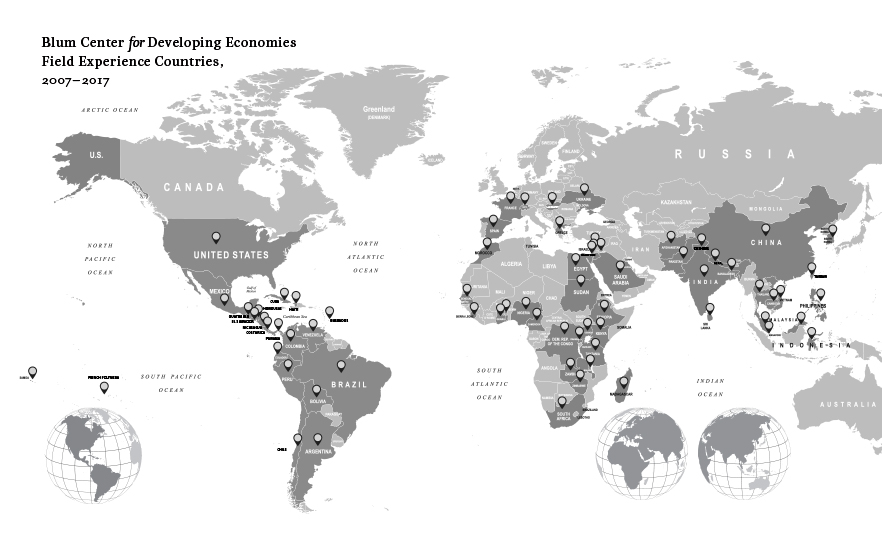We had no idea how many students would sign up for lectures on global poverty when that course first appeared in the catalogue for University of California, Berkeley undergrads in 2005. We hoped for thirty. More than a hundred registered.
Today, more than 15,000 students have taken one or more courses offered through our multidisciplinary center on poverty and income inequality, the Blum Center for Developing Economies. More than 700 have completed the rigorous minor-studies program in Global Poverty & Practice.
We’re still expanding. Each of ten campuses in the University of California system, the world’s largest public institution of higher education, has embraced and adapted this academic model, helping students follow their passion to defeat extreme poverty in the world and income inequality here in the United States.
Time in the field is an essential part of these studies, and that’s where hundreds of Berkeley undergrads are now and for the next few months. We want them to have a better understanding of problems people face in the developing world and of how to find their place as global citizens in the modern world.
In all, as the world map shows, Berkeley students have ventured to nearly 70 countries since the field experience program began in 2007. Most volunteer with nonprofits, governments, or community-based organizations in a developing country, but more are helping similar groups that serve poor communities in the United States.
I have been a fan of the Peace Corps– a beacon in people-to-people diplomacy– since I heard JFK propose the program in San Francisco a week before he defeated Richard Nixon in the 1960 election. In their eight-week immersion in the field, our students get a Peace Corps–like experience before they begin their careers. By the end of this summer, more than 800 students in the Global Poverty and Practice minor will have completed field studies.
We want students to think of themselves as apprentices, to approach their field experiences with modesty and humility, and to reflect more deeply about global poverty and their place in the world. They need to walk the villages. As I’ve written and said before, people in poor communities know how to improve their living situation. They too often lack the resources, training, and tools to make much progress.
The course that students take before heading into the field—Ethics, Methods, and Pragmatics—explores the countries and cultures where they will work. When they hit the ground, they better appreciate the cultural and political realities of that community.
They learn how to take a survey; how to document their experience with photos, videos, blogs, and so forth; and how to respect the place they are going and the people with whom they will live and interact.
After their field experience, students are required to reflect on what they learned in the field, mistakes they made, notable circumstances they encountered, and contradictions they observed. These seminars are important, instructive—and powerful.
After a field experience, students dive back into their classes, and many seek ways to stay connected somehow while continuing their campus studies. Often, they find a local organization in the Bay Area that provides experiences similar to what they found during their weeks in the field. Some sign on with advocacy groups in Washington, DC., or the Bay Area.
While poverty studies certainly could be worthy of an academic major, requiring a dozen courses or more, we elected to offer a minor. Deep knowledge from a major in most any academic field can be applied to alleviating poverty. Management, education, global health, pre-med, finance, nutrition, agriculture, chemistry, biology, electrical engineering, economics, computer science, government, public policy, international diplomacy, journalism—the list is endless.
Several universities connect studies in global development with social entrepreneurship in a business school. We decided engineering was a better fit for driving innovation with scalable impact and have collaborated closely with Berkeley’s world-class College of Engineering from the beginning.
“When you involve an engineering school in poverty studies, you appeal to a class of students who want to figure out how to do something,” explains former U.S. Secretary of State George P. Shultz.
Great universities need to keep pace with and respond to a rapidly changing world, just as businesses do in competitive markets.
As we’ve seen at Berkeley and other University of California campuses, highly motivated students today are eager for – and excel in – college experiences that prepare them to take on major challenges of the twenty-first century.
** **
World map graphic design adapted by Neil Gonzalez, art director of Greenleaf Book Group. Original map appears in An Accident of Geography at end of chapter 12, ”Merging Disciplines to Fight Poverty.”


Leave a Reply